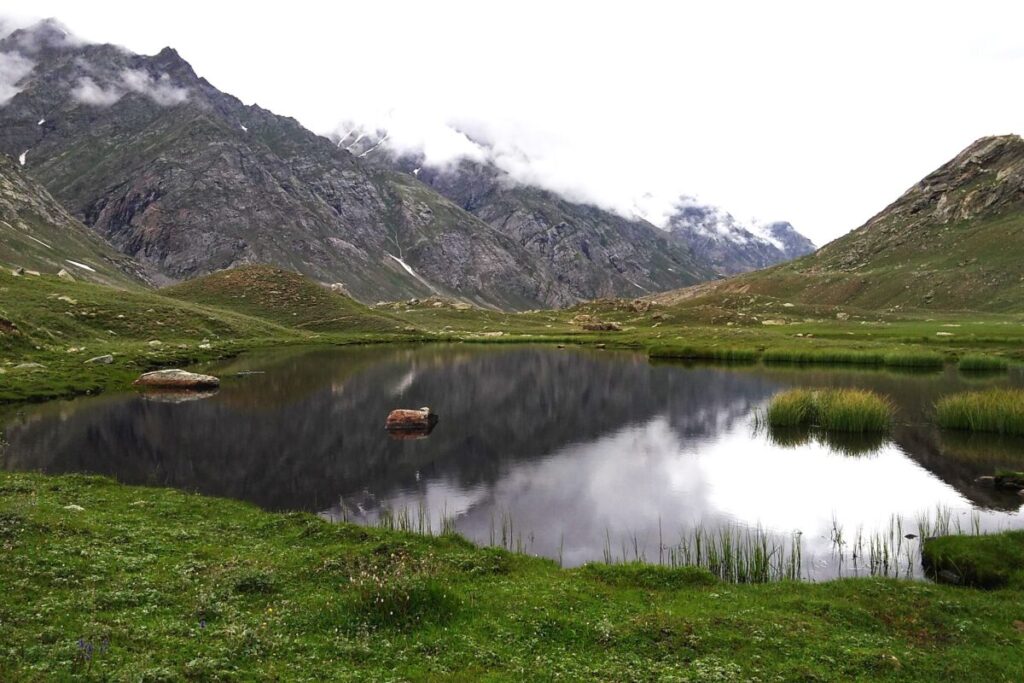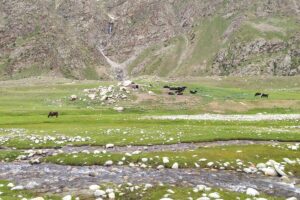Pressures On Gaddi Community Pose Threat To Biodiversity, Livelihoods
Jan 21, 2024 | Pratirodh Bureau
A small water body in Thanpattan pastures. Resource sharing between various stakeholders continues to test the resilience of the pasturelands of Thanpattan (Photo by Prateek Savita)
- Located in the Lahaul-Spiti district of Himachal Pradesh, Thanpattan is a vast pastureland, home to the indigenous Gaddi herder community and is also known for its rich biodiversity.
- The Gaddi herders have practised transhumant pastoralism for generations, and have coexisted with diverse wildlife including snow leopards, Himalayan brown bears, and various bird species.
- Recent research finds Thanpattan, an area of high conservation value, to be under pressure from excess grazing leading to rangeland degradation, and human-wildlife conflict. This threatens both the biodiversity in the region and the livelihood of the Gaddi pastoralists.
- The views in this commentary are those of the author.

Between the towering Pir Panjal and Zanskar ranges in the Himalayas, lies one of the largest pasturelands called Thanpattan, spanning approximately 570 square kilometres. As I walked the pastureland in the Lahaul-Spiti district of Himachal Pradesh with my team in 2019, we found ourselves following winding trails that seemed to disappear into the heart of the Himalayas. The air was crisp and the scent of wildflowers wafted in the breeze, creating an atmosphere of serenity.
Along one of these trails, we saw a herd of sheep and two herders sitting patiently behind the flock. Their faces bore marks of countless seasons spent in the mountains. Their eyes, weathered by years of observing the secrets of the mountains, held stories that stretch back generations. Who were these guardians of wilderness, and what hidden knowledge did they carry within the folds of their weather-beaten cloaks?
The Time-Honoured Traditions Of Gaddi Herders In The Himalayas
Amidst the Himalayan peaks of Lahaul Valley lives a community whose way of life is deeply intertwined with the rhythms of nature — the migratory herders of the Gaddi tribal community. In the northern and western regions of India, seasonal and migratory pastoralism is a common practice among transhumant tribes who typically graze their livestock, mainly sheep and goats, in the higher altitudes of alpine ranges during the summer months.

For generations, the Gaddi community, a tribe numbering over 178,000 in Himachal Pradesh, has practised transhumant pastoralism. The herders mostly utilise the milk, meat and wool for subsistence and earn a living by selling livestock. The pastures of Thanpattan region are of great significance for the local livestock herders as well as the herders of the Gaddi communities of the Chamba and Bharmaur districts. However, this migration is not just a matter of tradition; it’s a way of life that has been sustained for generations.
The grazing rights in this area were granted to the herders in the 1870s by the British. To regulate this, grazing permits were issued, allowing the herders’ access to the land for three years at a time. According to the forest department that has been collecting grazing dues since 1953, the rates have not changed in the last two decades — Rs. 20 per 100 sheep, Rs 40. per 100 goats and Rs 2. per horse. This revenue gets utilised as forest revenue, highlighting the delicate balance between tradition and regulation.
Thanpattan — A Biodiversity Haven
Several renowned protected areas such as Pin Valley National Park, Chandratal Wildlife Sanctuary, and Kibber Wildlife Sanctuary are located in Spiti Valley in the Lahaul-Spiti district. No such designated areas are present in Lahaul Valley, although fascinating wildlife thrives there.
In the wilderness of Thanpattan, predators like snow leopard, Himalayan brown bear and Tibetan wolf roam freely, sharing their habitat with herbivores such as the Asiatic ibex and the Himalayan musk deer. The region is also a sanctuary for avifaunal species like chukar, Himalayan snowcock, common cuckoo, red-billed chough, yellow-billed chough, horned lark, Eurasian wren, and more, and also medicinal plants such as Picrorhiza kurroa, Aconitum violaceum, Betula utilis, Aconitum heterophyllum, Podophyllum hexandrum, and Zurinea dolomiaea.
Our latest study has found that the patches of Thanpattan pastureland serve as a crucial corridor for animals with extensive range requirements like snow leopard and Himalayan brown bear as they share their boundaries with the Sechu Tuan Wildlife Sanctuary, Pangi Valley, Chamba, and the Union Territory of Ladakh. Thanpattan, with its remarkable flora and fauna, stands as a testament to the intricate balance of nature.
The study has underscored the significance of Thanpattan as a high conservation value area (HCVA), satisfying all six criteria of it. The high conservation value is a concept that stresses on the importance of involving local stakeholders in both the process and systematic survey of proposed sites, as well as making them an integral part of the decision-making process to facilitate participatory management.
Identifying similar HCVAs is essential for more innovative and inclusive conservation, including other effective area-based conservation measures (OECMs), and for working towards the Kunming Montreal Global Biodiversity Framework. An OECM is governed and managed to conserve biodiversity and ecosystem functions, similar to a Protected Area.
A Struggle For Co-existence
Thanpattan’s story is not just about the symbiotic relationship between the Gaddi people and their land. The meadows provide vital sustenance for not only the herders but also the diverse wildlife calling the region home. The narrative of this landscape is interwoven with ecological fragility, economic intricacies, and the struggle for coexistence.
The practice of livestock grazing presents its own challenges and threats to the landscape, leading to potential conflicts and threats to the unique wildlife present here. Despite limits on the permits, overstocking of livestock, driven by the necessity to sustain livelihoods, threatens the ecological balance of the land. The excess grazing leads to rangeland degradation. The consequences reverberate through the ecosystem, creating competition for resources between livestock and wild ungulates.
Disease transmission between domesticated and wild animals is a probable threat. As the wilderness loses its natural habitat due to human intrusions, conflicts between humans and wildlife become inevitable. The scarcity of wild prey in the region due to competitive exclusion leads to depredation of livestock. During our survey, 46% of the informants told us that human-wildlife conflict is a pressing issue in the landscape, with livestock depredation by large carnivores, Himalayan brown bears and snow leopards being the most common.
In the midst of these intertwined challenges, Thanpattan is resilient. It’s a reminder that amidst the complexities of ecological balance and the intricacies of economic survival, there is a profound need for understanding and cooperation. Collaborative efforts, involving local communities, authorities, and conservationists, are essential to safeguard the rich biodiversity of the Thanpattan pastures for future generations — a future where traditional knowledge meets modern conservation strategies.
As mentioned in our study, anthropogenic pressures on pastures cause damage to biodiversity and the livelihood of herders. Training forest officials and local communities in wildlife monitoring, wildlife law, and legislation is needed to mitigate these pressures. Additionally, implementing pastureland management schemes such as demarcating areas for livestock grazing within the pastures of Thanpattan to avoid competition, regulating pastureland degradation, and preventing the spread of diseases between livestock and ungulates, are possible solutions. Medical camps near entry points for the Gaddi community could help with disease surveillance. Achieving primary conservation goals of managing human-wildlife conflict and regulating livestock grazing and resource-use would only be possible with the active participation of the forest department and development of a suitable conservation plan.
As the winds whisper tales of centuries-old traditions and the call of the wild echoes through the meadows, the guardians of Thanpattan stand resilient. Their partnership with the land, if nurtured wisely, could script a harmonious future where biodiversity thrives, and the Gaddi heritage finds its rightful place in the history of conservation. The story of Gaddi herder community isn’t just about survival; it’s about the delicate art of coexisting with nature, respecting it, and preserving the intricate web of life.
(Published under Creative Commons from Mongabay-India. Read the original article here)
